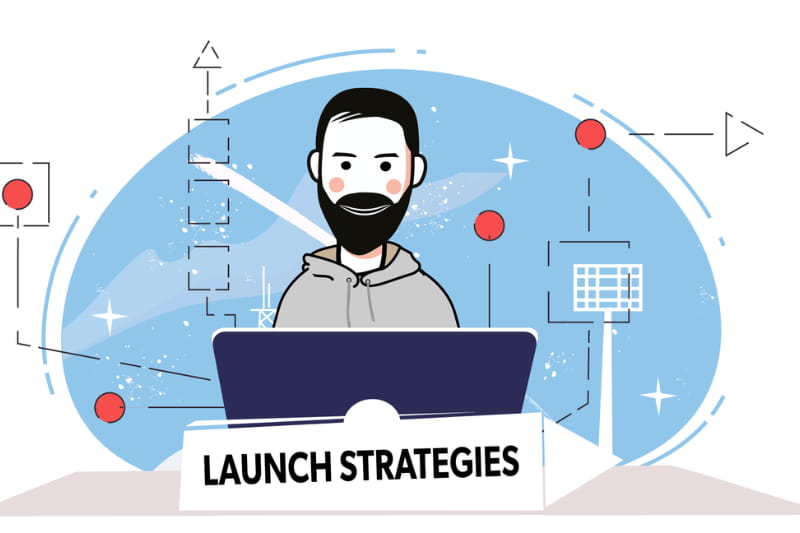Launching a new product is a pivotal moment for any business. A well-crafted product launch strategy can make the difference between a product that captivates the market and one that gets lost in the noise.
This guide will walk you through what a product launch strategy is, why it's important, the steps to create a successful strategy, and common pitfalls to avoid. Let's dive in!
What Is a Product Launch Strategy?
A strategy for product launch is a detailed plan outlining the steps necessary to introduce a new product or service into the market. It involves a combination of marketing, sales, and operational tactics designed to create awareness, generate demand, and drive sales for the new offering.
Unlike a basic product release, which focuses purely on making the product available, a strategic product launch includes pre-launch activities, market positioning, media and influencer outreach, and post-launch follow-up to maintain momentum. It aligns your company’s resources and goals to ensure the product has the best chance of success from day one.

The Importance of a Product Launch Strategy
Having a well-structured product launch strategy is critical for several reasons:
-
Creates Hype and Buzz – An effective launch plan helps build excitement around the new product. Through targeted marketing, social media, and PR, you can generate early interest and anticipation before the product is even available.
-
Targeted Messaging – A launch strategy ensures your messaging is crafted for your ideal audience. It helps define who you are selling to, what problems your product solves, and why your offering is better than the competition.
-
Mitigates Risk – Launching without a plan increases the chances of missing important steps, resulting in poor timing, budget overruns, or negative customer experiences. A strategy helps avoid costly mistakes.
-
Increases Market Penetration – With a strong product launch strategy, you can effectively capture a larger share of the market, improve brand visibility, and establish your product as a must-have item.
Essential Components of a Product Launch Strategy
To create a new product launch strategy that drives success, you need to include several key components:
-
Clear Objectives – Define what success looks like for the product launch. Is it brand awareness? A specific sales target? New market penetration? Knowing your goals will shape every decision in the process. For each objective made, the easiest way to make them clearer is to set goals based on the S.M.A.R.T framework - Specific, Measurable, Achievable, Relevant, and Time-bound, which will help you understand your objective better.
-
Understanding of the Target Audience – Identifying and understanding your target audience is crucial for tailoring your messaging and promotional efforts. Who will benefit most from your product? What are their pain points? You can start with market segmentation first, analyzing demographic, geographic, psychological and behavioral factors to come up with the exact target audience.
-
Product Positioning or Benchmarking – Determine how your product fits in the market. What makes it unique? Who are your competitors? Why should customers choose your product over others? Product positioning helps communicate your product’s value to potential buyers.
-
Product Launch Marketing and Promotional Plan – How will you create awareness and excitement? What is the big idea for the product launch event? Your marketing plan should include a mix of content marketing, social media campaigns, influencer partnerships, email marketing, and traditional advertising if appropriate.
-
Sales and Distribution Strategy – Consider how the product will be sold. Will it be available online, in stores, or both? Ensure your distribution channels are aligned with your launch goals.
-
Post-Launch Support – A product launch doesn’t end when the product becomes available. You need post-launch activities, such as customer support, user engagement, and follow-up marketing efforts, to keep the momentum going.

Tactics for Creating a Successful Product Launch Strategy
Creating an impactful strategy requires careful planning and execution. Here are some tactics to ensure success:
Research and Analyze the Market
Before launching, you need a deep understanding of the competitive landscape and customer preferences. Conduct market research to identify trends, competitors, and potential barriers to entry. Understanding what’s working (and what’s not) for other products in your industry helps refine your product release strategy.
Identify Your Target Audience
Knowing your target audience inside and out is essential. Use demographic data, market research, and customer personas to define who your ideal buyers are and what they value most. This will inform your messaging, marketing channels, and sales approach.
Create a Compelling Value Proposition
Your value proposition is the core of your messaging. It answers, “Why should customers care about this product?” A compelling value proposition clearly states the product’s benefits, how it solves a problem, and why it’s better than competitors. Normally, it is advisable to draw a positioning map, where you pick two features that can be your product’s value proposition. By comparing your competitors on those values, it will be easy for businesses to figure out suitable strategies to make the product’s value proposition stand out.
Develop a Comprehensive Launch Plan
Your launch plan should include timelines, marketing efforts, promotional activities, and sales strategies. It should outline specific goals for each stage of the launch, including pre-launch, launch day, and post-launch efforts. A strong product launch plan template will keep your team organized and on track.
Track and Measure Results
Once the product is launched, it's crucial to track and measure its performance. Monitoring KPIs such as sales numbers, website traffic, social media engagement, and customer feedback will help you gauge success and adjust your strategy if needed.
Examples of Successful Product Launch Events
Some of the world’s largest companies have mastered the art of a strategic product launch:

-
Apple’s iPhone Launches – Known for their secrecy and drama, Apple’s product launches are industry-defining events. The company creates buzz months in advance and hosts live events that generate global attention. Especially in their latest iPhone 16’s launching event “It’s Glowtime” on September 9, 2024, the product launch has been done creatively: from intentionally choosing Monday as their product release date, marking a significant shift from its usual Friday releases, to putting the background in AI concept.
-
Tesla’s Cybertruck Unveil – Despite a controversial reveal, Tesla’s Cybertruck launch garnered massive media coverage. By highlighting the vehicle’s unique design and promising groundbreaking features, Tesla sparked curiosity and demand.

These new product launch examples showcase how a well-executed strategy can capture the public’s attention and drive strong sales.
Common Reasons for Product Launch Failures
Not every launch is a success. Here are some common reasons why product launches fail:
-
Lack of Market Research – Without a solid understanding of the market and target audience, it’s easy to launch a product that doesn’t resonate with customers.
-
Poor Timing – Timing is everything. Launching too early or too late can negatively impact a product’s reception.
-
Inadequate Marketing – If your marketing efforts don’t generate enough buzz, your product may struggle to gain traction.
-
Overpromising and Under Delivering – Setting expectations too high can lead to customer disappointment if the product fails to meet those promises.
Difference Between a Product Launch Strategy and a Product Launch Plan
Although the terms are often used interchangeably, there’s a distinction between a product launch strategy and a product launch plan:
-
Product Launch Strategy refers to the overall approach and long-term vision for the launch. It encompasses the market positioning, target audience, and messaging tactics.
-
Product Launch Plan involves the practical steps required to execute the strategy, including timelines, budgets, marketing tactics, and logistics.
>> See detailed: What do we need to think about for product launching?
Both are critical, but the strategy provides the framework for the plan’s execution.
Conclusion
Crafting a strong product launch strategy is crucial for ensuring your product’s success in a competitive market. By following the steps outlined above - conducting thorough research, understanding your audience, and creating a comprehensive plan - you can maximize the impact of your launch and build a strong foundation for long-term growth.
If you're planning a product launch and need professional event-organizing services, VietnamEvent offers full-package product launch support. We handle everything from concept development to post-launch analysis, ensuring your event is a success. Please contact us today through the hotline, mobile, or WhatsApp here!
—--------------------------------------------------------------------------------
Contact information:
Vietnam Event | Local Brand - Global Expert
Hotline/Mobile/Whatsapp: (+84) 913 929 182 - (+84) 918 640 988
Email: annie@vietnamevent.com
-
29 Doan Thi Diem str., Dong Da dist., Hanoi
-
217 Tran Phu str., Hai Chau dist., Danang
-
5 Hoa Cau str., Phu Nhuan dist., Ho Chi Minh City
-
Others: Singapore


